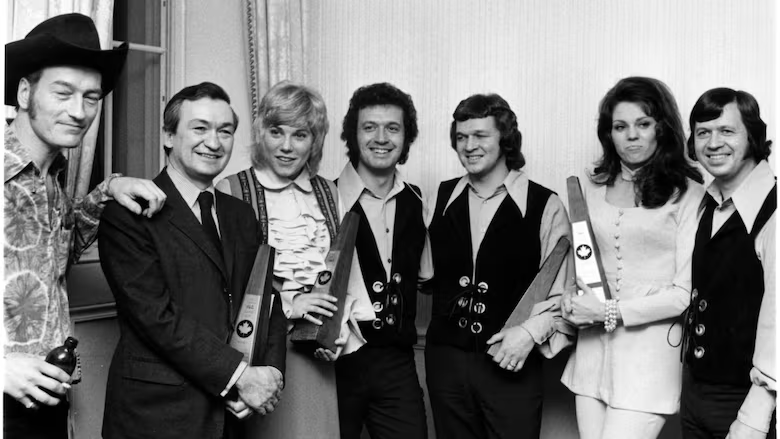How Canadian content rules influenced the music industry in the 1970s
Radio stations were required to play 30 per cent Canadian music on Jan. 18, 1971

After being postponed from earlier in 2021 because of the COVID-19 pandemic, the Juno Awards are scheduled to go ahead this Sunday, June 6.
This year, the awards are celebrating 50 years of recognizing achievements in the Canadian music industry.
Perhaps not coincidentally, it was also 50 years ago that Canadian content regulations, which were mandated by the Canadian Radio-Television and Communications Commission, came into force. The rules specified that 30 per cent of songs on radio station playlists must be Canadian if a radio station wanted a licence to operate in Canada.
But Canadian content laws got a bumpy start before anyone could know what they would mean for the Canadian music industry.
Ready ahead of schedule
Some Canadian artists were already on the radar at one radio station before the rules became official.
At country music station CFGM, an unidentified manager interviewed by a CBC reporter in January 1971 rhymed off the American artists who were most popular on his station before adding a Canadian name.
"I must also include Anne Murray," he added. "And, of course, she is Canadian."
The manager said that upon hearing about the forthcoming requirement, the station had done an assessment of the availability of Canadian artists and determined about 75 acts qualified — and of those, the station considered 20 to be "well-known," including Stompin' Tom Connors.
"We began a buildup of Canadian artists, including them in our format ... to see how well they can be integrated with the American product," he said. "Right now, we are at our 30 per cent requirement."
But a manager at CKAY, a "middle-of-the-road" station, said he anticipated trouble meeting the 30 per cent threshold because much of the Canadian music available was in the rock 'n' roll format.
"There's talent in this country," he said. "It just hasn't been financially feasible for record companies to produce middle-of-the-road music because it doesn't sell that well."
He was doubtful at the suggestion there might be a "Canadian sound" before correcting himself.
"I think Gordie Lightfoot is perhaps a distinctive Canadian sound."
The retail perspective
In April 1970, well before Cancon requirements began for radio, record retailer Sam Sniderman told Paul Soles of CBC's Take 30 that he viewed Canadian music as a "worthwhile venture."
He said his store, Sam the Record Man, supported Canadian music by playing the artists in the store and encouraging radio stations to play them, too.
"Once a record has been accepted by the public, then there's no difficulty at all in getting it off the ground, either in the stations or at the store."
Promoting Canadian music abroad
The year after Canadian content regulations for music were law, promoter Ritchie York wanted to do more for Canadian musicians. His solution involved boosting awareness among the European music press.
For him, it was a "problem" that all music from North America came across the Atlantic as American, despite Canadian acts being "million-sellers" in the U.S.
- FROM THE VAULTS | The time we brought 100 European record producers and reporters to Canada for the junket of a lifetime
His solution was what became known as the Maple Music junket in June 1972. He spoke to a CBC reporter about the media tour, which included showcases in Montreal and Toronto, in April that year.
"It's remarkable," he said. "They know nothing at all about Canada ... they have no idea of anything at all about this country. We've done a very bad job of promoting ourselves internationally."
'Tremendous repetition'
By 1975, the CBC business series Money Makers sought to understand the economics of the Canadian industry in recorded music, which was worth an estimated $250 million.
The record companies, which previously needed only to import a foreign master recording to manufacture records for the Canadian market, had felt the impact of the CRTC's Canadian content rules — and producing Canadian talent wasn't profitable.
"The amount of money that is being made from our Canadian right now is probably less than one per cent," said an unidentified industry representative.
Radio stations, meanwhile, complained there weren't enough Canadian records available.
"There is an average of only seven records produced each week," said a radio station spokesperson, noting that he needed to play five records an hour to meet the Cancon requirement. The result became "tremendous repetition" on the radio.
'They would like to be stars'
At the end of 1978, Cancon seemed to have had a positive effect on the Canadian music industry, as reporter Mike Duffy learned for CBC's The National.
"All across the country, recording studios are booming," Duffy said at the start of his report. He credited their success to the rules that had come into effect seven years earlier and to Walt Grealis, founder of RPM magazine and an early champion for Canadian content rules.
"The writers and publishers, their performance royalties have quadrupled," said Grealis. "It's opened the door for young musicians to get involved in an industry that they would like to be stars in. Some of them have and some more will."
According to the Globe and Mail, Grealis and his co-founder, Stan Klees, gave out the Gold Leaf Award starting in 1964. The idea of a ceremony, and a new nickname for the Canadian music industry awards — the Junos — came later, in 1971.






